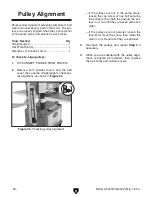
-31-
Model G0453Z/G0454Z (Mfg. 1/09+)
Review the troubleshooting and procedures in this section to fix or adjust your machine if a problem devel-
ops. If you need replacement parts or you are unsure of your repair skills, then feel free to call our Technical
Support at (570) 546-9663.
SECTION 7: SERVICE
Troubleshooting
Motor & Electrical
Symptom
Possible Cause
Possible Solution
Machine does not
start or a breaker
trips.
1. Stop push-button engaged/faulty.
2. Power supply switched OFF or at fault.
3. Thermal overload relay has tripped.
4. Wall circuit breaker tripped.
5. Plug/receptacle at fault/wired wrong.
6. Motor connection wired wrong.
7. Contactor not energized/has poor contacts.
8. Wiring open/has high resistance.
9. ON/OFF switch at fault.
10. Start capacitor at fault.
11. Centrifugal switch at fault.
12. Motor at fault.
1. Rotate button to reset/replace it.
2. Ensure power supply is on/has correct voltage.
3. Reset; adjust trip load dial if necessary; replace.
4. Ensure circuit size is correct/replace weak breaker.
5. Test for good contacts; correct the wiring.
6. Correct motor wiring connections (
Pages 44–45).
7. Test all legs for power/replace if faulty.
8. Check/fix broken, disconnected, or corroded wires.
9. Replace switch.
10. Test/replace if faulty.
11. Adjust/replace centrifugal switch.
12. Test/repair/replace.
Machine stalls or is
underpowered.
1. Feed rate too fast.
2. Workpiece material not suitable.
3. Dust collection ducting problem.
4. Motor overheated.
5. Machine undersized for task.
6. V-belt(s) slipping.
7. Motor wired incorrectly.
8. Plug/receptacle at fault.
9. Run capacitor at fault.
10. Pulley/sprocket slipping on shaft.
11. Motor bearings at fault.
12. Contactor not energized/has poor contacts.
13. Motor at fault.
14. Centrifugal switch at fault.
1. Decrease feed rate.
2. Only cut wood/ensure moisture is below 20%.
3. Clear blockages, seal leaks, use smooth wall duct,
eliminate bends, close other branches.
4. Clean motor, let cool, and reduce workload.
5. Use sharp blades/inserts; reduce feed rate or depth
of cut.
6. Tension/replace belt(s) (
Page 35); ensure pulleys
are aligned (
Page 36).
7. Wire motor correctly (
Pages 44–45).
8. Test for good contacts/correct wiring.
9. Test/repair/replace.
10. Replace loose pulley/shaft.
11. Test/repair/replace.
12. Test all legs for power/replace if faulty.
13. Test/repair/replace.
14. Adjust/replace centrifugal switch.
Machine has
vibration or noisy
operation.
1. Belts slapping cover.
2. V-belt(s) worn or loose.
3. Pulley loose.
4. Motor mount loose/broken.
1. Replace/realign belts with a matched set.
2. Inspect/replace belts with a new matched set.
3. Realign/replace shaft, pulley, setscrew, and key.
4. Tighten/replace.
Summary of Contents for G0453Z
Page 68: ......
















































